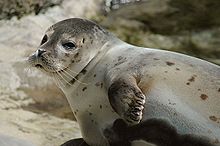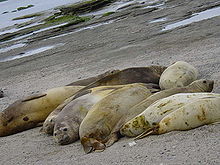
Earless seal
Did you know...
This Schools selection was originally chosen by SOS Children for schools in the developing world without internet access. It is available as a intranet download. To compare sponsorship charities this is the best sponsorship link.
| Earless seals Temporal range: 15–0Ma Middle Miocene to Recent |
|
|---|---|
 |
|
| Common Seal, Phoca vitulina | |
| Scientific classification |
|
| Kingdom: | Animalia |
| Phylum: | Chordata |
| Class: | Mammalia |
| Order: | Carnivora |
| Clade: | Pinnipedia |
| Superfamily: | Phocoidea |
| Family: | Phocidae Gray, 1821 |
| Genera | |
|
|
The true seals or earless seals are one of the three main groups of mammals within the seal superfamily, Pinnipedia. All true seals are members of the family Phocidae (pron.: / ˈ f oʊ s ə d iː /). They are sometimes called crawling seals to distinguish them from the fur seals and sea lions of the family Otariidae. Seals live in the oceans of both hemispheres and are mostly confined to polar, subpolar, and temperate climates, with the exception of the more tropical monk seals.
Anatomy
Adult phocids vary from 1.17 meters (3.8 ft) in length and 45 kilograms (99 lb) in weight, in the ringed seal, to 4.9 meters (16 ft) and 2,400 kilograms (5,300 lb) in the southern elephant seal.
Phocids are more specialized for aquatic life than otariids. They lack external ears and have sleek, streamlined bodies. Retractable nipples, internal testicles and an internal penis sheath provide further streamlining. A smooth layer of blubber lies underneath the skin. Phocids are able to divert blood flow to this layer to help control their temperatures.
Limbs
Their fore flippers are used primarily for steering, while their hind flippers are bound to the pelvis in such a way that they cannot bring them under their body to walk on them.
They are more streamlined than fur seals and sea lions, so can swim more effectively over long distances. However, because they cannot turn their hind flippers downward, they are very clumsy on land, having to wriggle with their front flippers and abdominal muscles.
Phocids have fewer teeth than land-based members of the Carnivora, although they retain powerful canines. Some species lack molars altogether. The dental formula is: 2-3.1.4.0-21-2.1.4.0-2
Physiology
Respiration and circulation
Phocid respiratory and circulatory systems are adapted to allow diving to considerable depths, and they can spend a long time underwater between breaths. Air is forced from the lungs during a dive and into the upper respiratory passages, where gases cannot easily be absorbed into the bloodstream. This helps protect the seal from the bends. The middle ear is also lined with blood sinuses that inflate during diving, helping to maintain a constant pressure.
Life history
Swimming
While otariids are known for speed and maneuverability, phocids are known for efficient, economical movement. This allows most phocids to forage far from land to exploit prey resources, while otariids are tied to rich upwelling zones close to breeding sites.
Phocids swim by sideways movements of their bodies, using their hind flippers to fullest effect.
Communication
True seals do not communicate by "barking" like otariids. Instead, they communicate by slapping the water and grunting.
Reproduction
Phocids spend most of their time at sea, although they return to land or pack ice to breed and give birth.
Pregnant females spend long periods foraging at sea, building up fat reserves, and then return to the breeding site to use their stored energy to nurse pups. The common seal displays a reproductive strategy similar to that of otariids in which the mother makes short foraging trips between nursing bouts.
Because a phocid mother's feeding grounds are often hundreds of kilometers from the breeding site, she must fast while lactating. This combination of fasting with lactation requires the mother to provide large amounts of energy to her pup at a time when she is not eating (and often, not drinking). Mothers must supply their own metabolic needs while nursing. This is a miniature version of the humpback whale's strategy. They fast during their months-long migration from arctic feeding areas to tropical breeding/nursing areas and back.
Phocids produce thick, fat-rich milk that allows them to provide their pups with large amounts of energy in a short period. This allows the mother to return to the sea in time to replenish her reserves. Lactation ranges from five to seven weeks in the monk seal to just three to five days in the hooded seal. The mother ends nursing by leaving her pup at the breeding site to search for food (pups continue to nurse if given the opportunity). "Milk stealers" that suckle from unrelated, sleeping females are not uncommon; this often results in the death of the mother's pup, since a single female can only feed one pup.
Growth and maturation
The pup's diet is so high in calories, it builds up a fat store. Before the pup is ready to forage, the mother abandons it, and the pup consumes its own fat for weeks or months while it matures. Seals, like all marine mammals, need time to develop the oxygen stores, swimming muscles, and neural pathways necessary for effective diving and foraging. Seal pups typically eat no food and drink no water during the period, although some polar species eat snow. The postweaning fast ranges from two weeks in the hooded seal to 9–12 weeks in the northern elephant seal. The physiological and behavioural adaptations that allow phocid pups to endure these remarkable fasts, which are among the longest for any mammal, remain an area of active study and research.
Taxonomy
In the 1980s, phylogenetic analysis of the phocids has led to a few conclusions about the interrelatedness of the various genera. The four genera Hydrurga, Leptonychotes, Lobodon, and Ommatophoca form a monophyletic group, the tribe Lobodontini. Likewise, the Phocinae subfamily ( Erignathus, Cystophora, Halichoerus, and Phoca) is also monophyletic. More recently, five species have been split off from Phoca, forming three additional genera. However, the family Monachinae (the lobodonts plus Monachus and Mirounga) is probably paraphyletic.
Superfamily Pinnipedia
- Family Otariidae: Fur seals and sea lions
- Family Odobenidae: Walrus
- Family Phocidae
- Subfamily Monachinae
- Tribe Monachini
- † Monachopsis
- † Pristiphoca
- † Properiptychus
- † Messiphoca
- † Mesotaria
- † Callophoca
- † Pliophoca
- † Pontophoca
- Hawaiian monk seal, Monachus schauinslandi
- Mediterranean monk seal, Monachus monachus
- † Caribbean monk seal, Monachus tropicalis (probably extinct around 1950)
- Tribe Miroungini
- Northern elephant seal, Mirounga angustirostris
- Southern elephant seal, Mirounga leonina
- Tribe Lobodontini
- † Monotherium wymani
- Ross seal, Ommatophoca rossi
- Crabeater seal, Lobodon carcinophagus
- Leopard seal, Hydrurga leptonyx
- Weddell seal, Leptonychotes weddellii
- † Acrophoca longirostris
- † Piscophoca pacifica
- † Homiphoca capensis
- Tribe Monachini
- Subfamily Phocinae
- † Kawas benegasorum
- † Leptophoca lenis
- † Preapusa
- † Cryptophoca
- Bearded seal, Erignathus barbatus
- Hooded seal, Cystophora cristata
- Tribe Phocini
- Common seal or harbour seal, Phoca vitulina
- Spotted seal, Phoca largha
- Ringed seal, Pusa hispida (formerly Phoca hispida)
- Baikal seal, Pusa sibirica (formerly Phoca sibirica)
- Caspian seal, Pusa caspica (formerly Phoca caspica)
- Harp seal, Pagophilus groenlandicus (formerly Phoca groenlandica)
- Ribbon seal, Histriophoca fasciata (formerly Phoca fasciata)
- † Phocanella
- † Platyphoca
- † Gryphoca
- Grey seal, Halichoerus grypus
- Subfamily Monachinae
Evolution
The earliest fossil phocids date from the mid-Miocene, 15 million years ago in the north Atlantic. Until recently, many researchers believed phocids evolved separately from otariids and odobenids from otter-like animals, such as Potamotherium, which inhabited European freshwater lakes. Recent evidence strongly suggests a monophyletic origin for all pinnipeds from a single ancestor, possibly Enaliarctos, most closely related to the bears.
Monk seals and elephant seals are believed to have first entered the Pacific through the open straits between North and South America, which closed only in the Pliocene. The various Antarctic species may have either used the same route, or traveled down the west coast of Africa.



